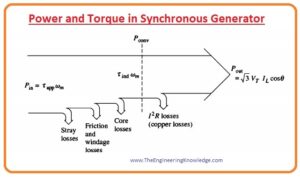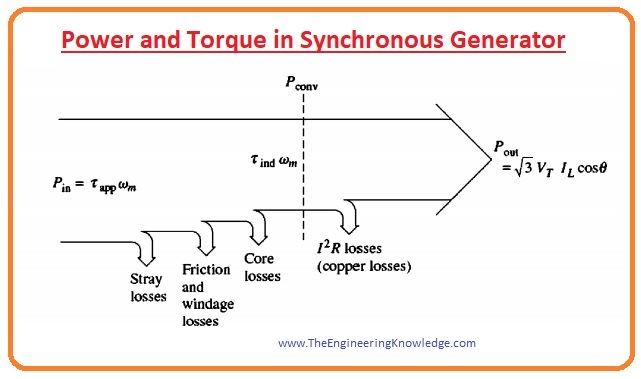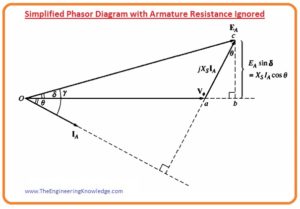 Hello friends, I hope all of you are fine. In today’s tutorial, we are gonna have a look at the Power and Torque in Synchronous Generator and their relationship. The synchronous generator is an apparatus that alters mechanical energy into electrical energy. To move its shaft there are many sources like steam turbines, petrol engines or water turbines that provided mechanical energy to the generator. These sources of mechanical power are named as a prime mover.
Hello friends, I hope all of you are fine. In today’s tutorial, we are gonna have a look at the Power and Torque in Synchronous Generator and their relationship. The synchronous generator is an apparatus that alters mechanical energy into electrical energy. To move its shaft there are many sources like steam turbines, petrol engines or water turbines that provided mechanical energy to the generator. These sources of mechanical power are named as a prime mover.
It does not matter which prime mover we are using; the main thing is that it should rotate the rotor at a constant speed irrespective of the variation in the power demand. If the prime mover does not deliver the continuous speed, then the frequency of the power generated by the generator will not be the same. In today’s post, we will have a look at the relation between torque and power of the synchronous generator. so let’s get started with the power and torque in the synchronous generator.
Power and Torque in Synchronous Generator
- The mechanical power provided by the prime mover to the synchronous generator does not transform into electrical power completely.
- The mechanical power that does not convert into electric energy is called loss power.
- The power flow diagram of synchronous generators is described below.
- In the power flow diagram of a synchronous generator, The power provided by the prime mover to the generator is.
Pin = Tappwm
- Whereas, this input power converted to electricity is given here.
Pcon = Tindwm
Pcon = 3EAIAcosγ
- In this equation, the EA is the internally generated voltage of the generator IA is the armature current, γ is the angle between them.
- The power that does not convert into electric energy is wasted in the form of core losses that are eddy current and hysteresis loss, iron loss, windage, and friction losses.
Power of the Synchronous Generator
- let find the power equation of synchronous generator,
- The out power of the generator that is electrical power can be written as.
Pout =√3 VTIL Cosø
- It can be written in phase form.
Pout =3 VøIA Cosø—-(1)
- The reactive power of the generator can be defined as
Qout =√3 VTIL Sinø
- It can also be written in phase form.
Qout =3 VøIA Sinø
- As the Xs>>RA, so if we neglect the armature resistance (RA) then a very valuable expression can b finds to define the Pout of the synchronous generator.
- To find this expression we study the given phasor diagram.
- It is the simple phasor diagram of the generator without the armature resistance.
- From a diagram, you can see that the bc portion has the value of EAsinor XsIAcosø.
- so, we have
IAcosø = EAsinδ/Xs
- If we put this expression in equation (1) then we have.
P=3 Vø EAsinδ/Xs——- (2)
- As there is no resistance in equation (2) so there is no loss in the generator and this equation is for input and the output of the generator.
- From equation (2) we can observe that the output power of the synchronous generator depends on the angle (δ) between the internal generated voltage EA and the phase (terminal) voltage of the generator.
- The angle (δ) is also called the torque angle of the synchronous generator.
- The extreme power that can generator produce will be given when the value of torque angle (δ) is ninety degrees.
- When δ =900, sin =1, so the power will be.
Pmax =3VøEA/Xs —- (3)
- The maximum power given in this equation is known as the static stability limit of the generator.
- Usually, practically no generator reaches this limit.
- If we observe given below equation again.
Pout =3 VøIA Cosø—-(1)
Qout =3 VøIA Sinø
P=3 Vø EAsinδ/Xs——- (2)
- Let’s suppose that the Vø in these three equations is constant than the outputs of the active powers are directly proportionate to the IA Cosø and the EA Sinø and the reactive power (Q) is proportionate to the IA Sinø.
- These factors are beneficial for the construction of the phasor diagram of the generator when the load varies.
Torque in Synchronous Generator
- As we know the torque in the synchronous machine is given as.
Tind =KBR x BS
Tind =KBR x Bnet—-(d)
- The magnitude of the equation (d) can be written as.
Tind =KBRBnetsinδ
- In this equation the δ is the angle among the field of the rotor (BR) and the net field of the generator (Bnet), it is known as the torque angle.
- Another equation for the torque can be calculated by this equation.
P=3 Vø EAsinδ/Xs
- As we know that the converted power (Pconv) = Tindwm, so the induced generator torque or synchronous generator is.
Tind= 3 Vø EAsinδ/wmXs ——(f)
- Equation ‘f’ gives the value of the torque in the form of electric numbers but the given below equation gives the torque in the form of magnetic terms.
Tind =KBRBnetsinδ
You can also read some related topics to synchronous generators that are listed here.
Introduction to Synchronous Generator
Synchronous Generator Equivalent Circuit
Synchronous Generator Phasor Diagram
Synchronous Generator Parameters
Synchronous Generator Operating Alone
Synchronous Generator Parallel Operation
Synchronous Generator parallel with Large Power system
Synchronous Generator Parallel with same Size Generator
Synchronous Generator Capability Curves
Synchronous Generator Transients
That is the complete article on the power and torque of synchronous generators and power and torque relation, if you want to know something more ask in the comments. See you in the next tutorial Synchronous Generator Parameter.










Good web site you’ve got here.. It’s hard to find excellent writing like yours
these days. I really appreciate individuals like you!
Take care!!
Thanks for the terrific information for us.
King regards,
Harrell Griffin
Thanks for discussing your ideas here. The other point is that any time a problem takes place with a laptop or computer motherboard, people should not go ahead and take risk of repairing that themselves for if it is not done correctly it can lead to permanent damage to all the laptop. It is almost always safe just to approach the dealer of any laptop for the repair of the motherboard. They have got technicians that have an expertise in dealing with pc motherboard complications and can get the right diagnosis and undertake repairs.
Good answers in return of this query with real arguments and explaining everything concerning that.
Ӏt’s genuinely very complex in this active life to listen news on Television, thus I only use internet for that ρurpose, and obtain tһe latest
news.
Нighly descrіptive bⅼog, I lοved that a
lot. Will there be a part 2?
Like!! I blog quite often and I genuinely thank you for your information. The article has truly peaked my interest.
Thanks for a marvelous posting! I actually enjoyed reading it, you may be a great author.I will remember to bookmark your blog and will eventually come back very soon. I want to encourage you to continue your great posts, have a nice weekend!
You are so awesome! I don’t think I’ve truly read anything like
this before. So good to find another person with original thoughts on this issue.
Seriously.. thank you for starting this up.
This web site is something that is required on the internet, someone
with some originality!